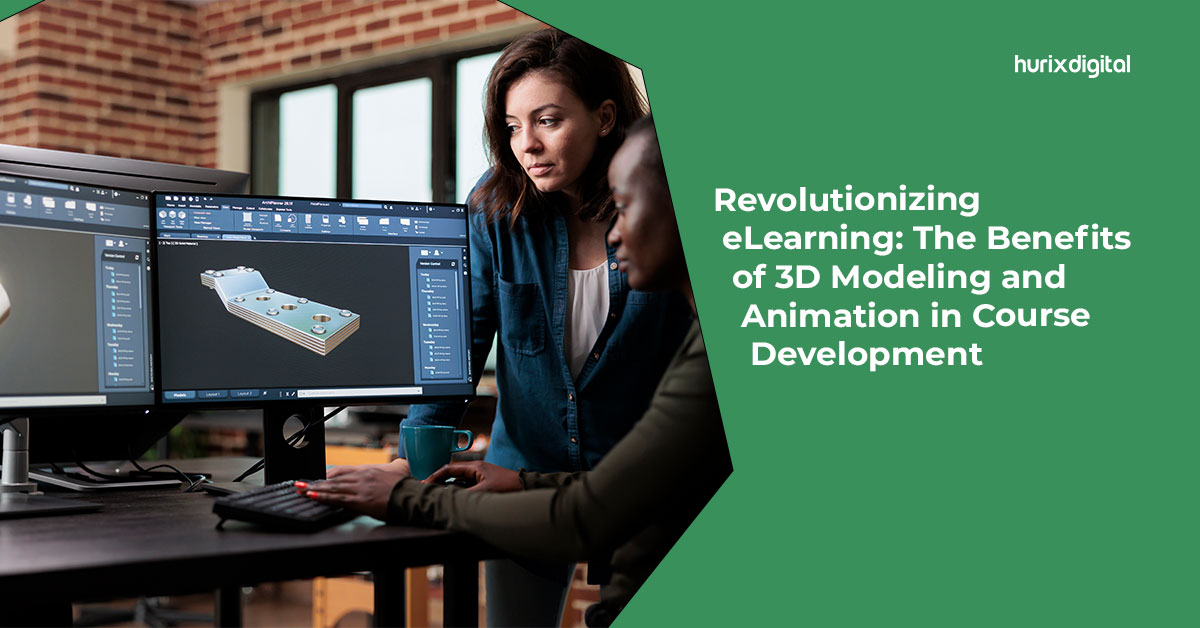
Revolutionizing ELearning: The Benefits Of 3D Modeling And Animation In Course Development
The pandemic has transformed the education sector in several ways. One of the most paramount changes in the education sector was the rise of e-learning and e-learning platforms. Since most of the world was in a complete lockdown, online learning became an indispensable tool for institutions and teachers to ensure uninterrupted education and engage with students remotely.
However, e-learning course development had its unique shortcomings. One of the most common was that e-learning courses were less interactive and engaging than classroom programs. To overcome these problems, many organizations use animations and 3D modeling in their online program development to make them more engaging and fun.
In this blog, we will see how animation and 3D modeling have revolutionized e-learning and the benefits of using them during course development.
Table of Contents:
- The Need For 3D Modeling And Animation In E-Learning Course Development
- Benefits Of 3D Modeling And Animation In Course Development
- How To Use 3D Modeling And Animation In Course Development?
- Final Thoughts
The Need For 3D Modeling And Animation In E-Learning Course Development
The thing about online e-learning course development is that it lacks physical stimulation. Without proper physical stimulation and a lack of face-to-face interaction, learners may experience challenges in developing practical skills. This may also hinder their ability to build interpersonal connections.
To overcome this issue and to make e-learning in higher education more interactive, fun, and relevant, digital aspects like 3D modeling and animations are incorporated into the course development. 3D modeling is the three-dimensional representation of pictures, figures, and objects.
Similarly, 3D animations make all the pictures, figures, and objects come to life by creating an illusion that they are moving. 3D modeling is the initial step that can eventually be transformed into 3D animations to create realistic moving structures.
Using such interactive objects in e-learning course development improves the quality of e-learning. Furthermore, they drive the learners’ attention quickly and get the most out of it efficiently.
Benefits Of 3D Modeling And Animation In Course Development
3D modeling and animation have become essential tools for e-learning course development. It is becoming increasingly popular among organizations to use digital objects to create surreal learning experiences for their students.
According to Statista, the global 3D animation modeling market is valued at 8.1 billion dollars in 2023. It is further expected to be valued at 11.6 billion dollars by 2026. These numbers depict the global growth of the 3D modeling and animation industry.
Let’s look at the key benefits of incorporating 3D modeling and animations in online program development. And why you should not miss it too!
1. It Creates Engaging Learning Experiences
According to a study conducted in 2019 in the Czech, it was concluded that digital elements like 3D modeling and animations positively impact student learning experiences. The use of these resources also motivated students to learn about natural sciences.
Furthermore, learners are more likely to stay focused and engaged when exploring 3D visuals and animations.
2. It Enhances Visual Memory
According to research by the American Physiology Society, decorative animations can improve visual memory by providing learners with an engaging visual experience. Learners are more likely to remember visuals from 3D objects and models than from traditional text-based course material.
This way, they would be able to retain more and break the monotony of regular text-based learning materials.
3. It Creates An Interactive Environment
3D modeling and animation allow learners to interact more with the course content. This helps them better understand the material and allows them to ask questions and get feedback from the instructor.
Furthermore, 3D modeling and animation can be used to create quizzes, assessments, and other interactive elements in the course, making the learning experience more effective and efficient.
4. Cost-Effective Solution
Online 3D design courses and animation courses are relatively easier to produce and do not break the bank. Furthermore, the wide availability of online tools and resources, such as animation courses online, has made producing animations even easier.
This makes animation and 3D modeling great options for businesses looking to create highly interactive and fun training programs and instructional videos.
How To Use 3D Modeling And Animation In Course Development?
Now that you all know the perks of incorporating animations and 3D modeling into the course to enhance the e-learning experience, it is now time to understand how to structure an online course and what are some good practices to incorporate these digital objects into your course.
Here are some Dos and Donts to keep in mind while adding animations and 3D modeling in courses:
Dos
- Do use animations and 3D modeling to enhance the learning experience and strengthen the key concepts.
- Do make sure that the animations and 3D models are relevant to the course content and align with the learning objectives.
- Do keep the animations and 3D models visually appealing, engaging, and interactive to capture learners’ attention.
- Do test the animations and 3D models across different devices and platforms to ensure compatibility and smooth functionality.
- Do provide clear instructions or guidance on interacting with the animations or manipulating the 3D models, if applicable.
- Do consider accessibility by providing alternative text or descriptions for learners with visual impairments.
Don’ts
- Don’t overload the course with excessive or unnecessary animations and 3D models that may distract or confuse learners.
- Don’t rely solely on animations and 3D models to deliver information. You can use them as supplements to text-based content.
- Don’t use animations or 3D models that are overly complex or difficult to understand, as they may confuse the learners.
- Don’t compromise on the quality of the animations or 3D models. Poor visuals can compromise the credibility and quality of the course.
- Don’t assume that all learners will have access to high-end devices or internet connections capable of running complex animations or 3D models. Consider different user scenarios and optimize the course accordingly.
- Don’t forget to provide clear navigation or instructions on how to navigate through the animations courses online. Also, make sure that learners can easily explore and interact with them.
By considering these dos and don’ts, you can effectively incorporate animations and 3D modeling into e-learning course development to create engaging and impactful learning experiences for your students.
Final Thoughts
Using 3D modeling and animation in course development has been a revolutionary change in e-learning. Courses developed using these tools are far more interactive, engaging, and fun. Thus, all organizations that want to create impactful training courses or even webinars must make use of these interactive tools to give an edge to their course.
Hurix Digital offers comprehensive solutions for 3D modeling and animation e-learning course development. We have expertise in creating engaging and interactive learning experiences through their course development services. We also understand the unique requirements of their clients and develop tailor-made animation courses and 3D modeling courses online to meet their specific needs.
We aim to deliver immersive, visually rich, and effective learning experiences that engage learners and derive desired learning outcomes.
Contact us today to learn more about our services!
Also Related – 9 Reasons Why Custom eLearning Solutions Are Better Than Off-the-Shelf Courses

Performance, Results, Growth, and Life-Long Learning define my professional life. I am passionate about making workplace learning planful, purposeful, and impactful. I take pride in partnering with clients and bringing them the best in learning design and creating solutions that address business challenges.




